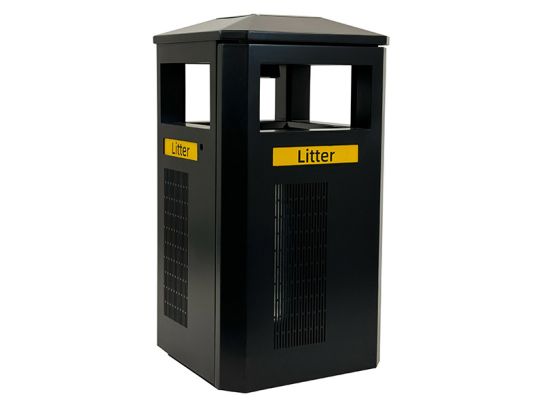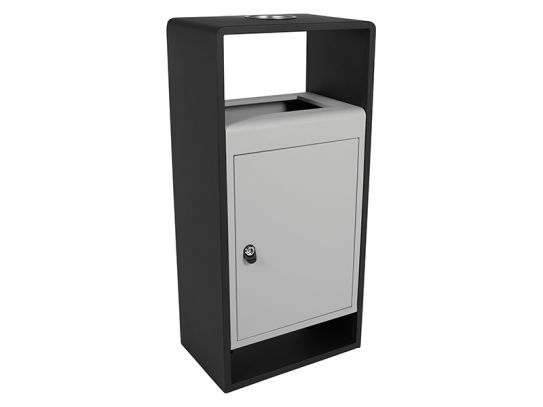Litter Bins
Clean up Your Community With Our Durable Litter Bins
Keep your public spaces clean and tidy with our range of durable and weather-resistant metal litter bins. Made from high-quality stainless steel, our bins are built to withstand the elements and the test of time. Whether you're looking to add a touch of elegance to your park, community centre, or outdoor sporting ground, our bins are the perfect solution for waste management. With little maintenance required, you'll be able to enjoy a cleaner, more attractive environment for years to come. Upgrade your space today with our range of premium metal litter bins.
What Are Litter Bins?
Litter bins are containers used for the disposal of waste, specifically for litter or rubbish, in public spaces such as parks, streets, and other outdoor areas. They are typically made of durable materials such as metal or plastic and are designed to be weather-resistant and easy to maintain. They are often provided by local governments or other organisations to promote cleanliness and prevent littering in public spaces.
What Are Some Common Uses for Litter Bins?
Litter bins are commonly used in a variety of outdoor public spaces such as:
- Parks and recreational areas: They are used to collect waste generated by visitors and keep the area clean.
- Streets and pavements: They are used to collect litter and waste from pedestrians and vehicles.
- Public transportation stations and terminals: They are used to collect waste generated by commuters and travellers.
- Shopping centres and malls: They are used to collect waste generated by shoppers.
- Sports and entertainment venues: They are used to collect waste generated by visitors and spectators.
- Hospitals, schools, and other public buildings: They are used to collect waste generated by visitors and staff.
Litter bins are designed to make it easy for people to dispose of their waste properly, helping to keep public spaces clean and tidy.
What Are the Different Types of Litter Bins?
There are several different types of litter bins, each with their own unique features and benefits. Some common types include:
- Stainless steel bins: These bins are made of high-quality stainless steel and are designed to be weather-resistant and durable.
- Plastic bins: These bins are made of plastic and are lightweight, easy to clean and move around.
- Recycling bins: These bins are designed specifically for the collection of recyclable materials such as paper, plastic, and cans.
- Dome-top bins: These bins have a dome-shaped lid, which helps to reduce odours and prevent rainwater from entering the bin.
- Wall-mounted bins: These bins are designed to be mounted to a wall or post, making them ideal for use in tight spaces.
- Ashtray bins: These bins have an ashtray built into the top, making them ideal for use in smoking areas.
- Bag holder bins: These bins have a holder for the rubbish bags, making it easy to change the bags.
- Combination bins: These bins have multiple compartments, allowing for the separation of different types of waste, such as recycling and general waste.
The type of litter bin you choose will depend on the specific needs of your location and the type of waste you are looking to collect.
What Are the Key Features to Consider When Choosing Litter Bins?
When choosing litter bins, there are several key features to consider:
- Capacity: Consider the amount of waste that will need to be collected and choose a bin with a capacity that can accommodate that amount.
- Durability: Look for bins made of durable materials that can withstand heavy use and the elements.
- Weather resistance: If the bin will be placed in an outdoor location, choose one that is weather-resistant and can withstand exposure to rain, sun, and wind.
- Aesthetics: Litter bins are designed to be functional and also an aesthetic feature of a location. Choose a design that will complement the area and enhance the overall appearance.
- Easy to maintain: Consider the ease of cleaning and maintenance when choosing a bin. Look for bins with removable liners or that can be easily cleaned with a hose or a pressure washer.
- Accessibility: Make sure the bin is placed in an accessible location and is easy to use for everyone.
- Security: If the area is prone to vandalism, consider purchasing a bin that is lockable or made of durable materials that can withstand damage.
- Recycling: Consider purchasing recycling bins to promote recycling and reduce the amount of waste sent to landfills.
By considering these key features, you can ensure that you choose a litter bin that is both functional and suitable for the specific needs of your location.
What Are the Best Materials for Litter Bins?
The best materials for litter bins will depend on the specific needs of the location and the type of waste that will be collected. Some commonly used materials include:
- Stainless Steel: This is a durable and weather-resistant material that is easy to clean and maintain. It is also resistant to rust and corrosion, making it a good choice for outdoor use.
- Polyethylene: This is a type of plastic that is lightweight, durable and weather-resistant. It is also resistant to UV rays and can withstand extreme temperatures.
- Powder-coated steel: This is a durable and weather-resistant material that can withstand heavy use. It's also rust-resistant.
- Wood: This is a natural and eco-friendly material, it can be used for litter bins in parks or other natural environments, but it requires more maintenance.
- Concrete: This is a heavy-duty and durable material that can withstand heavy use and harsh weather conditions.
- Aluminium: This is lightweight, durable and weather-resistant material, and it's also rust-resistant.
The choice of material will depend on the specific needs of the location, the type of waste that will be collected, and budget. Stainless steel and polyethylene are popular choices for litter bins due to their durability and weather-resistance.
How Do I Maintain and Clean Litter Bins?
Maintaining and cleaning litter bins will depend on the specific type of bin and the materials it is made of. Here are some general guidelines for cleaning and maintaining litter bins:
- Regularly empty the bin: Litter bins should be emptied regularly to prevent overflowing and keep the area clean.
- Clean the bin: Use a mild detergent and water to clean the bin, or a pressure washer for heavy-duty cleaning.
- Disinfect the bin: Use a disinfectant solution to clean the bin and prevent the spread of germs.
- Check for damage: Inspect the bin for damage, such as dents or cracks, and repair or replace as necessary.
- Rinse the bin: Rinse the bin with water to remove any remaining dirt or cleaning solution.
- Dry the bin: Allow the bin to dry completely before placing it back in its location.
- Change the liner: If the bin has a removable liner, make sure you change it regularly and dispose of the waste properly.
- Secure the bin: If the bin is in a high-risk area for vandalism or theft, make sure it is secured to the ground or a wall.
By following these guidelines, you can ensure that your litter bin is kept in good condition and continues to serve its purpose effectively.
Are There Any Guidelines for the Placement of Litter Bins in Public Spaces?
Yes, there are guidelines to ensure that litter bins are placed in locations that are easily accessible and convenient for users, while also minimising the potential for littering and other negative impacts. Some of the key guidelines include:
- Accessibility: Litter bins should be placed in locations that are easily accessible to the public, such as near sidewalks, walkways, and entrances to buildings.
- Visibility: Litter bins should be placed in locations that are visible to the public, such as near busy street corners or in well-lit areas, to encourage use.
- Proximity to sources of litter: Litter bins should be placed near sources of litter, such as food vendors, picnic areas, and other high-use areas.
- Space for placement and maintenance: Litter bins should be placed in locations that provide enough space for proper placement and maintenance, such as a flat surface, enough space for a wheelbarrow to access the bin, and enough space for the bin to be cleaned.
- Safety: Litter bins should be placed in locations that do not pose a safety hazard, such as near busy roads or in areas with heavy foot traffic.
- Compliance with local regulations: Litter bins should be placed in accordance with local regulations and codes, such as zoning laws and building codes.
- Compatibility with the environment: Litter bins should be placed in locations that are compatible with the environment, such as in natural areas, they should be in harmony with the surrounding area.
By following these guidelines, you can ensure that litter bins are placed in locations that are convenient, safe, and effective for waste management.
What Safety Considerations Should Be Taken Into Account When Using Litter Bins?
When using litter bins, it's important to consider safety to prevent accidents and injuries. Here are some safety considerations to keep in mind:
- Placement: Litter bins should be placed in locations that are easily accessible but do not pose a safety hazard, such as near busy roads or in areas with heavy foot traffic.
- Visibility: Litter bins should be placed in locations that are visible to the public, such as near busy street corners or in well-lit areas, to reduce the risk of accidents.
- Lid: The lid of the bin should be secure, to prevent children or animals from getting inside.
- Sharp edges: The bin should be designed without sharp edges, to prevent cuts and scrapes.
- Fire safety: Some litter bin materials can be a fire hazard, such as those made of wood, they should be placed away from any potential sources of fire.
- Pest and wildlife control: Litter bins should be designed to prevent pests and wildlife from accessing the waste, to reduce the risk of bites and other hazards.
- Cleaning and maintenance: Litter bins should be cleaned and maintained regularly, to reduce the risk of germs and other hazards.
- Disposing of hazardous materials: Litter bins should not be used for disposing of hazardous materials, such as batteries or chemicals, as they can cause injury or damage to the environment.
- Signage: Proper signage should be placed near the litter bin to indicate the correct usage and safety instructions.
By keeping these safety considerations in mind, you can ensure that the litter bins are used safely and effectively, and that the public is protected from potential hazards.
Are There Any UK or European Industry Regulations That Apply to Litter Bins?
Yes, there are industry standards and regulations that apply to litter bins in the UK and Europe. These standards and regulations are intended to ensure that litter bins are designed, manufactured, and installed to a high level of quality and safety.
In the UK, the British Standard BS EN 840-1:2018 applies to litter bins, it provides guidelines for design, strength, durability, and safety of litter bins. It also includes guidelines for the testing of litter bins to ensure they meet the standard.
In the EU, the standard EN 840-1:2018 applies to litter bins, it includes guidelines for the design, strength, durability, and safety of litter bins. It also includes guidelines for the testing of litter bins to ensure they meet the standard.
Furthermore, there are also regulations regarding the use of litter bins and waste management in public spaces in the UK and Europe, such as the EU Waste Framework Directive, that aims to promote waste reduction and recycling, and the UK's Environmental Protection Act 1990, which regulates the management of waste in England and Wales.

